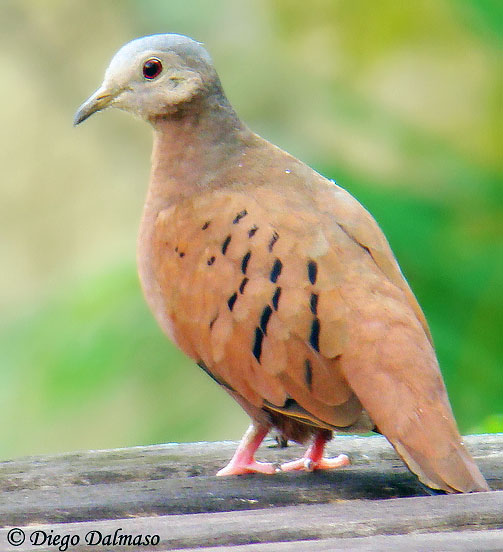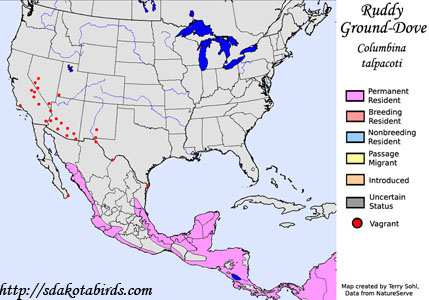| Length: 6.75 inches | Wingspan: 11 inches | Seasonality: Non-resident in South Dakota |
| ID Keys: Gray head with reddish eye, dark marks on wings. "Western" populations are primarily grayish, while "Eastern" populations are primarily a very rich rufous color. Females are paler than males. | ||
 The
Ruddy Ground-Dove is a small dove species that is common in much of southern
Mexico, Central America, and parts of South America. They have been
expanding their range in northwestern Mexico, and sightings of the species
in the southwestern U.S. have been increasing in recent years, with
sightings across a number of states. Most birds seen in the United
States are found in the fall and winter.
The
Ruddy Ground-Dove is a small dove species that is common in much of southern
Mexico, Central America, and parts of South America. They have been
expanding their range in northwestern Mexico, and sightings of the species
in the southwestern U.S. have been increasing in recent years, with
sightings across a number of states. Most birds seen in the United
States are found in the fall and winter.
Habitat: Found in a variety of open and semi-open habitats, including grassland and savannah, edges of open woodland, and suburban areas and parks. Disturbed (clear-cut) forest areas are often quickly colonized by Ruddy Ground-Doves in their tropical range, and they have also adopted well to cultivated areas.
Diet: Feeds on seeds and grains, and lesser quantities of insects and spiders.
Behavior: Feeds by walking along the ground, picking up seeds with its bill.
Nesting: The nest, a shallow structure of sticks and grasses, is built in shrubs or trees, usually within 4 to 10 feet from the ground, but sometimes lower in thick shrubs or higher in trees. Nests are sometimes constructed on top of existing nests built by other species. The females lays 2 eggs, and both parents help to incubate them. Both parents help to feed the young after they hatch. The young usually leave the nest after about 2 weeks. Ruddy Ground-Doves often produce more than one brood per season.
Song: The song of a Ruddy Ground-Dove is a series of cooing phrases.
Migration: Considered a permanent resident throughout its range. However, there may be some dispersal of post-breeding birds, given the number of sightings across a wide geographic region of the southwestern United States.
Interactive eBird Map: Click here to access an interactive eBird map of Ruddy Ground Dove sightings
Similar Species: Common Ground-Dove
Conservation Status: Populations are large, widespread, and may be increasing. The IUCN lists the Ruddy Ground-Dove as a species of "Least Concern".
Further Information: 1) Audubon Guide - Ruddy Ground-Dove
2) USGS Patuxent Bird Identification InfoCenter - Ruddy Ground-Dove
3) Life History of the Ruddy Ground-Dove
Photo Information: Photo taken by Diego Dalmaso - July 22nd, 2005 - Paragominas, Para, Brazil - Photo licensed under Creative Commons Attribution NonCommercial ShareAlike 2.0 Generic License.
| Click below for a higher-resolution map |
 |
| South Dakota Status: Non-resident in South Dakota |
Additional Ruddy Ground-Dove Photos (coming soon!!)
